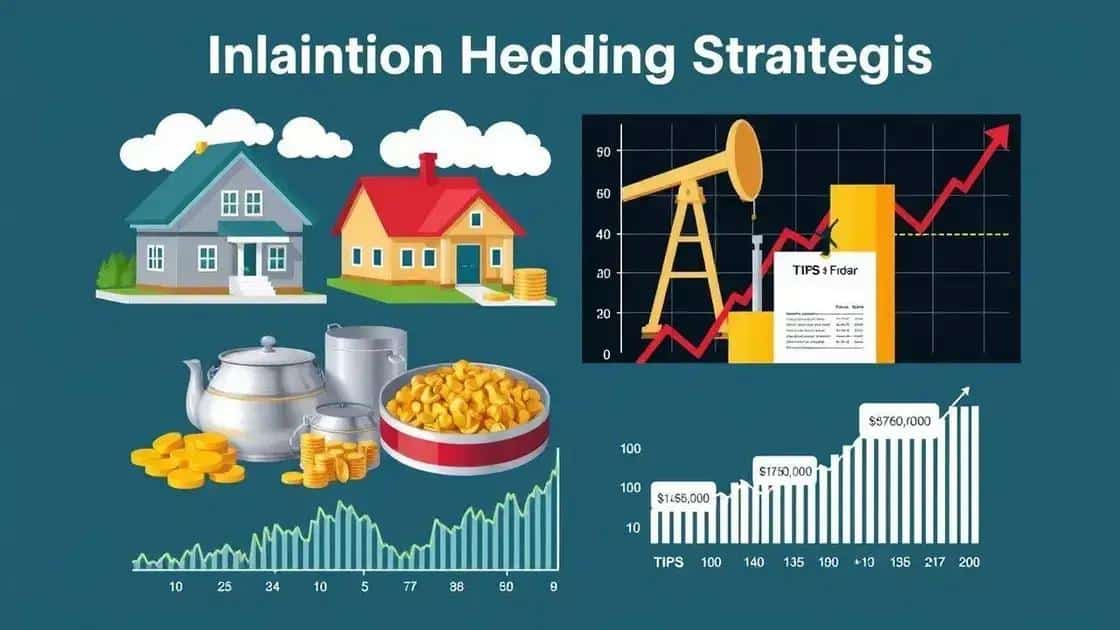Inflation hedging strategies: an emerging trend worth exploring

Inflation hedging strategies include real estate, commodities, and TIPS, which protect investments from rising prices and help maintain purchasing power during inflationary periods.
Inflation hedging strategies are becoming increasingly relevant in today’s economic landscape. As inflation rates fluctuate, it’s essential to explore how these strategies can safeguard your investments.
Understanding inflation hedging
Understanding inflation hedging is crucial for investors looking to protect their wealth during times of rising prices. Hedging can act as a shield against inflation, ensuring that your investments maintain their value.
One of the foundational concepts of inflation hedging is recognizing the different ways inflation can affect purchasing power. When prices increase, the value of money decreases. Therefore, it’s essential to consider assets that can potentially outpace inflation.
What is Inflation Hedging?
The term inflation hedging refers to strategies used by investors to guard against the erosion of purchasing power due to inflation. Various assets can be considered when developing an effective hedging strategy.
Common Inflation-Hedging Assets
- Real estate: Property often appreciates in value over time and can provide rental income that keeps pace with or exceeds inflation.
- Commodities: Physical goods like gold and oil typically rise in value during inflationary periods.
- TIPS: Treasury Inflation-Protected Securities (TIPS) are government bonds specifically designed to increase in value with inflation.
- Stocks: Shares in companies that can pass on higher costs to consumers may provide a reasonable hedge against inflation.
By understanding these options, investors can make informed decisions about their portfolios. It’s necessary to analyze how these investments perform in different economic scenarios.
Moreover, diversification plays a key role in an effective inflation hedging strategy. By spreading your investments across various asset classes, you can reduce risk while still protecting against inflation. This approach minimizes the impact on your overall portfolio during economic shifts.
Evaluating Your Options
When creating a portfolio, assessing each asset’s potential performance during inflationary periods is vital. Historical data can offer insights into how assets behaved during past inflation spikes.
Additionally, it’s essential to revisit your hedging strategy regularly. Economic conditions change, and regular adjustments ensure that your investments align with your financial goals. Over time, staying informed about inflation trends can lead to better decision-making.
Understanding inflation hedging puts you in a stronger position. By recognizing how to utilize various assets effectively, you can protect your wealth and maintain purchasing power despite the economic landscape.
Popular strategies used today

Today, various inflation hedging strategies are being utilized by investors to safeguard their assets. Each strategy offers unique benefits, and understanding them can help in making informed decisions.
Real Estate Investments
Investing in real estate is one of the most popular methods for hedging against inflation. As property values tend to rise over time, real estate can provide both appreciation and rental income.
- Income generation: Rental properties can produce a steady cash flow that often increases with inflation.
- Asset appreciation: Real estate typically appreciates at a rate higher than inflation.
- Tax benefits: Real estate investments may offer tax deductions that can enhance returns.
By diversifying into real estate, investors can create a balanced portfolio that withstands inflationary pressures.
Commodities and Precious Metals
Another effective hedge is investing in commodities, such as gold, silver, and oil. These assets are typically seen as stores of value.
Commodities can significantly benefit during inflation because their prices often rise when inflation increases. For example, gold is considered a safe haven during economic uncertainty, preserving wealth and purchasing power.
Stocks can also act as a hedge, especially if the companies can pass on rising costs to consumers. Investing in businesses that can maintain profit margins during inflation can enhance portfolio resilience.
TIPS (Treasury Inflation-Protected Securities)
One might consider TIPS when looking for a direct way to protect against inflation. These securities are specifically designed to adjust with inflation, ensuring your investment’s value increases over time.
For anyone interested in inflation hedging, understanding these popular strategies is key. Each option comes with its advantages and potential risks, so conducting thorough research is crucial for effective portfolio management.
Assessing the risks involved
Assessing the risks involved in inflation hedging strategies is key to making informed investment decisions. While these strategies can provide protection against rising prices, they also come with their own set of challenges and uncertainties.
One major risk is market volatility. The prices of assets used for hedging can fluctuate significantly, especially commodities like oil or gold. This volatility can lead to sudden losses, impacting overall portfolio performance.
Types of Risks to Consider
Investors should be aware of various types of risks associated with inflation hedging:
- Market risk: Changes in market conditions can affect the value of hedging assets.
- Interest rate risk: Rising interest rates can decrease the value of certain fixed-income investments, including TIPS.
- Liquidity risk: Some hedging assets, like real estate, may not be easily sold in a quick market downturn.
- Political risk: Geopolitical events can suddenly affect commodity prices and market stability.
Understanding these risks allows investors to set realistic expectations and strategies. Implementing proper risk management techniques, such as diversification and regular portfolio reviews, can help mitigate potential downsides.
Additionally, assessing personal risk tolerance is essential. Different investors may react differently to market changes, so creating a hedging strategy that fits your risk profile is crucial.
Furthermore, monitoring current economic indicators can provide valuable insights into when to adjust your inflation hedging approach. Awareness of trends can help navigate uncertain economic climates.
Case studies of successful hedging

Case studies of successful inflation hedging provide valuable insights into how different strategies can be effectively employed. By examining real-world examples, investors can learn the best practices and common pitfalls associated with their investments.
One notable case is that of investors who used real estate as a hedge against inflation. During the inflation spike of the 1970s, properties in urban areas appreciated significantly. This appreciation was coupled with rising rental income, which helped investors maintain their purchasing power.
Successful Real Estate Investments
Investors bought rental properties, creating a cash flow that exceeded inflation rates. Properties located in high-demand areas attracted constant tenant interest, ensuring steady income even in tough economic times.
- Location matters: Properties in desirable areas typically see better appreciation.
- Long-term planning: Investors who held properties during inflationary periods often realized substantial gains.
- Monitor market conditions: Keeping an eye on economic indicators helped investors make timely decisions.
Another effective strategy was seen with commodities like gold. Many investors turned to gold as a hedge during economic uncertainty, especially before the 2008 financial crisis.
Strategies with Commodities
Gold prices surged when inflation fears mounted, illustrating how commodities can act as a safe haven. Experienced investors diversified their portfolios by adding gold, oil, and other commodities:
- Preparedness: Those who anticipated inflation were able to act quickly and secure their assets.
- Long-term investment: Holding commodities over time paid off as prices increased.
Furthermore, businesses also adapted to inflation by raising prices. Companies with strong pricing power effectively resisted the impacts of inflation, showcasing that stocks in resilient sectors often provided good hedges.
These case studies demonstrate that effective decision-making and a well-researched approach to inflation hedging can result in favorable outcomes. By analyzing past successes and failures, investors can refine their strategies for the future.
In conclusion, understanding inflation hedging strategies is essential for anyone looking to protect their investments in an unpredictable economy. Through this article, we have highlighted effective methods such as real estate, commodities, and TIPS. Each strategy has its own benefits and risks, and case studies show that informed decisions lead to success. By carefully assessing these options and regularly monitoring market trends, investors can effectively navigate inflation and keep their wealth intact.
FAQ – Frequently Asked Questions about Inflation Hedging Strategies
What are inflation hedging strategies?
Inflation hedging strategies are investment approaches designed to protect against the loss of purchasing power due to rising prices. These include assets like real estate, commodities, and TIPS.
How does real estate help in hedging against inflation?
Real estate tends to appreciate in value during inflationary periods, providing both capital appreciation and rental income that often exceeds inflation rates.
Why are commodities considered a good hedge against inflation?
Commodities like gold and oil usually increase in value when inflation rises, making them reliable stores of value during economic uncertainty.
What role do TIPS play in inflation hedging?
Treasury Inflation-Protected Securities (TIPS) are government bonds that adjust their principal value based on inflation, ensuring that your investment keeps pace with rising prices.





